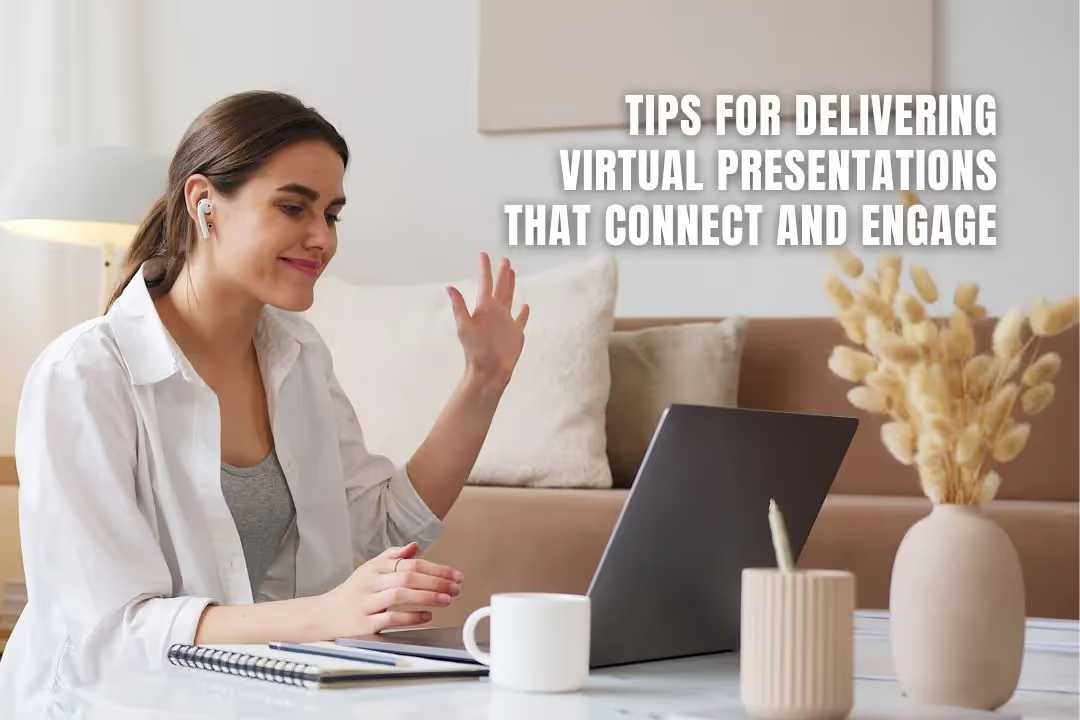
Virtual presentations are now a mainstay in just about every industry. But let’s be real — presenting to an online audience can sometimes feel… a bit distant. Without the immediate feedback and energy of a live crowd, it’s easy to worry about keeping people engaged. Thankfully, with the right techniques, you can still create a strong connection, get your message across, and leave a lasting impact.
This guide covers practical tips to help you deliver virtual presentations that truly resonate. Whether you’re experienced or just starting out, these insights will give you the tools to speak with confidence and connect with your audience. And if you’re looking to elevate your visuals, consider consulting a professional PowerPoint presentation agency for a polished slide deck.
Each virtual platform — be it Zoom, Microsoft Teams, or Google Meet — has its own unique features. Familiarise yourself with the platform you’ll be using; if you’re new to it, take a few moments to explore its capabilities, such as polls, breakout rooms, or screen-sharing options. A quick test run can make all the difference and help you feel at ease.
Technical glitches can happen, but thorough preparation helps keep them to a minimum. Check your audio and video settings, ensure a stable internet connection, and have all your slides and visuals ready. Investing in a decent microphone can make a world of difference for sound quality, and good lighting can help you come across clearly.
Choose a quiet, uncluttered space for presenting. Aim for a clean background and good lighting — natural light or a ring light works wonders. If your room echoes, soft furnishings or a rug can help absorb sound, reducing distractions for your audience.
Placing your camera at eye level makes it feel like you’re looking directly at your audience. This small detail can help you build a stronger connection compared to looking at the screen or your own reflection.
Even in a virtual setting, body language still counts. Simple gestures and facial expressions can add a spark to your presentation. Try to keep your hands visible to reinforce your points, and don’t be afraid to smile or nod to show warmth and engagement.
It might feel odd at first, but focusing on the camera rather than the screen keeps the attention on your audience. This subtle adjustment makes viewers feel as though you’re addressing them directly.
A single tone throughout the presentation can make your message less impactful. Switch up your pitch, pace, and volume as you go along to maintain interest. Pauses can also be powerful, giving listeners a moment to digest key points.
Before you present, warm up your voice — a few simple exercises can help reduce tension and improve clarity. Try humming or doing gentle vocal stretches to loosen up.
Intentional pauses create emphasis and help your audience absorb information. A well-placed pause gives your message a moment to resonate without feeling hurried.
Involve your audience with interactive tools like polls, quizzes, and Q&A. These small interactions break up the flow and make your presentation feel more like a conversation than a lecture.
Mentioning people by name or asking direct questions helps keep attention. You could ask, “Sarah, what’s your experience with this?” or “Who else has encountered this situation?” This approach invites participation and makes your audience feel seen.
Sharing a quick story, a bit of humour, or a personal anecdote can make your content more relatable. These “triggers” keep things lively and help maintain interest.
Slides should support your points without overwhelming your audience. Stick to clear headings, minimal text, and a cohesive colour scheme to keep your slides clean and easy to follow.
Adding a video, an infographic, or a brief demonstration can enhance your message. Just be mindful not to overdo it; in virtual presentations, simpler visuals often have the most impact.
Keep each slide focused on one main idea. A cluttered slide can dilute your message and make it harder for your audience to follow along.
Issues are bound to pop up now and then. If they do, staying calm and addressing the problem openly goes a long way. A simple “Thanks for your patience while I get this sorted” reassures your audience and keeps things professional.
Keep a few basics in mind, like reconnecting audio or switching devices if needed. Having a backup of your slides (like a PDF) or a second device nearby can be invaluable.
If a major issue arises, be transparent. Acknowledging the problem and showing appreciation for your audience’s patience can actually strengthen rapport.
Practice doesn’t just make perfect; it makes comfortable. Run through your presentation with a friend or colleague and take note of any spots where you feel uncertain. Adjust as needed to improve your flow.
Recording a practice run helps you catch details you might otherwise miss, like pacing or eye focus. Use these insights to fine-tune before the actual presentation.
Every presentation is a chance to refine your skills. The more you present, the more confident and engaging you’ll become.
Summing up the main points helps your audience remember key information. A quick recap also reinforces your messages and ends your presentation on a strong note.
Give your audience something to do next. Invite questions, encourage them to connect on social media, or offer additional resources for those interested.
Always end with a genuine thank you. Acknowledging their time and attention leaves a positive final impression.
While virtual presentations can seem daunting, a few thoughtful techniques can help you engage your audience just as well as if you were in the room with them. Use these tips as a foundation and adapt as you go along. With practice, each presentation will feel like an opportunity to make a real impact.